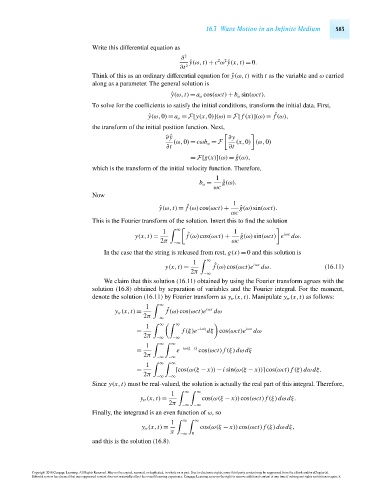Page 603 - Advanced_Engineering_Mathematics o'neil
P. 603
16.3 Wave Motion in an Infinite Medium 583
Write this differential equation as
∂ 2 2 2
ˆ y(ω,t) + c ω ˆy(x,t) = 0.
∂t 2
Think of this as an ordinary differential equation for ˆy(ω,t) with t as the variable and ω carried
along as a parameter. The general solution is
ˆ y(ω,t) = a ω cos(ωct) + b ω sin(ωct).
To solve for the coefficients to satisfy the initial conditions, transform the initial data. First,
ˆ y(ω,0) = a ω = F[y(x,0)](ω) = F[ f (x)](ω) = f (ω),
ˆ
the transform of the initial position function. Next,
∂ ˆy ∂y
(ω,0) = cωb ω = F (x,0) (ω,0)
∂t ∂t
= F[g(x)](ω) =ˆg(ω),
which is the transform of the initial velocity function. Therefore,
1
b ω = ˆ g(ω).
ωc
Now
1
ˆ
ˆ y(ω,t) = f (ω)cos(ωct) + ˆ g(ω)sin(ωct).
ωc
This is the Fourier transform of the solution. Invert this to find the solution
1 ∞ 1 iωx
ˆ
y(x,t) = f (ω)cos(ωct) + ˆ g(ω)sin(ωct) e dω.
2π −∞ ωc
In the case that the string is released from rest, g(x) = 0 and this solution is
1 ∞
ˆ
y(x,t) = f (ω)cos(ωct)e iωx dω. (16.11)
2π
−∞
We claim that this solution (16.11) obtained by using the Fourier transform agrees with the
solution (16.8) obtained by separation of variables and the Fourier integral. For the moment,
denote the solution (16.11) by Fourier transform as y tr (x,t). Manipulate y tr (x,t) as follows:
1 ∞ iωx
ˆ
y tr (x,t) = f (ω)cos(ωct)e dω
2π
−∞
1 ∞ ∞
= f (ξ)e −iωξ dξ cos(ωct)e iωx dω
2π
−∞ −∞
1 ∞ ∞
= e −iω(ξ−x) cos(ωct) f (ξ)dω dξ
2π
−∞ −∞
1 ∞ ∞
= [cos(ω(ξ − x)) − i sin(ω(ξ − x))]cos(ωct) f (ξ)dω dξ.
2π
−∞ −∞
Since y(x,t) must be real-valued, the solution is actually the real part of this integral. Therefore,
1 ∞ ∞
y tr (x,t) = cos(ω(ξ − x))cos(ωct) f (ξ)dω dξ.
2π
−∞ −∞
Finally, the integrand is an even function of ω,so
1 ∞ ∞
y tr (x,t) = cos(ω(ξ − x))cos(ωct) f (ξ)dω dξ,
π
−∞ 0
and this is the solution (16.8).
Copyright 2010 Cengage Learning. All Rights Reserved. May not be copied, scanned, or duplicated, in whole or in part. Due to electronic rights, some third party content may be suppressed from the eBook and/or eChapter(s).
Editorial review has deemed that any suppressed content does not materially affect the overall learning experience. Cengage Learning reserves the right to remove additional content at any time if subsequent rights restrictions require it.
October 14, 2010 15:23 THM/NEIL Page-583 27410_16_ch16_p563-610

